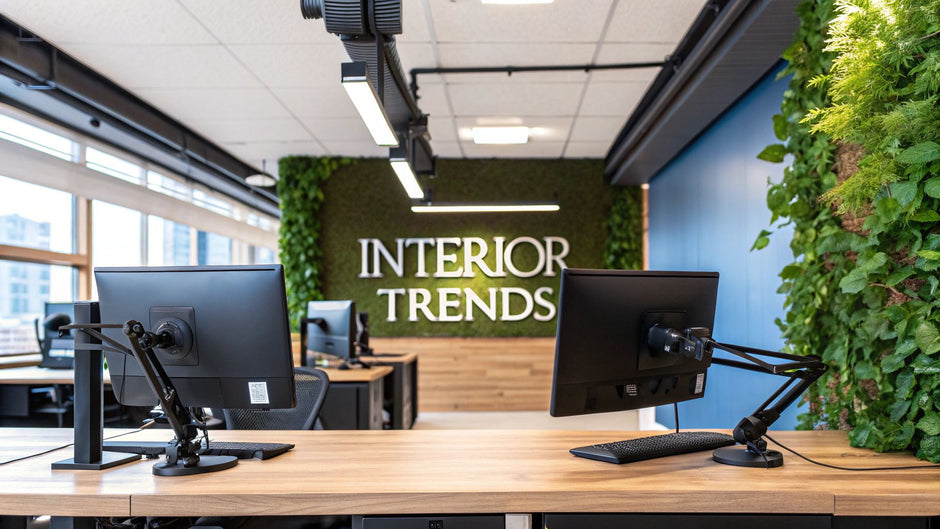Commercial interior design has come a long way from the sea of sterile, gray cubicles that once defined corporate America. The focus today is on creating dynamic, human-centric ecosystems—spaces that don't just function but actively shape culture, boost productivity, and support employee well-being. The most successful designs are flexible, tech-integrated, and deeply connected to nature. For a comprehensive look at the products that bring these trends to life, check out our collection of commercial solutions.
The Workspace Revolution: From Cubicles to Collaboration Hubs
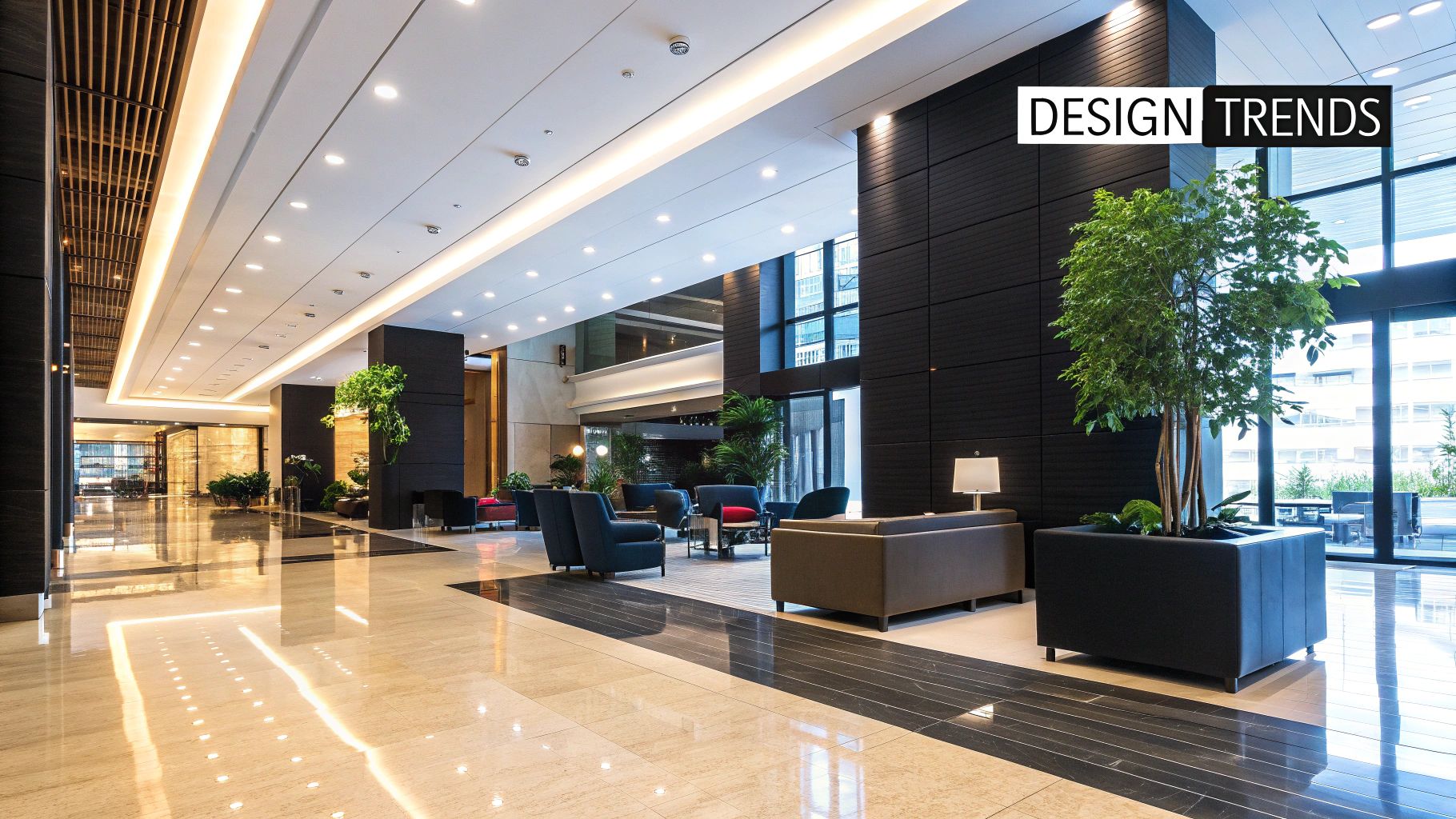
Let’s be honest, the days of endless, identical cubicles are numbered. A massive shift is underway, driven by a new understanding of how our physical environment impacts everything from employee morale to the bottom line. A thoughtfully designed office is no longer just an overhead cost; it’s a powerful strategic asset.
This transformation is a direct response to a changing work culture. With fierce competition for top talent, companies have to offer more than just a good salary. They need to provide an environment that supports health, sparks creativity, and embraces different work styles. This is where smart design becomes a real game-changer.
Why Modern Office Design Matters
This isn’t just a fleeting trend. The move toward more thoughtful commercial interiors is backed by serious market growth. In 2023, commercial interior design made up about 55% of the entire global interior design market, showing just how much businesses are investing in their spaces. North America is leading the charge, holding the largest revenue share at 33.79%, thanks to a heavy focus on smart technology and wellness.
But this shift is about so much more than just looking good. It’s about creating spaces that actively help a business succeed. A well-designed office can:
- Boost Productivity: When you offer a mix of spaces—like quiet pods for deep focus and open lounges for brainstorming—employees can pick the spot that best fits the task at hand.
- Improve Employee Well-being: Simple things like natural light, comfortable ergonomic furniture, and a few plants have been proven to lower stress and improve overall health.
- Strengthen Company Culture: The physical layout of an office sends a clear message about a company's values, whether that’s open collaboration, heads-down innovation, or a healthy mix of both.
Below is a quick look at the main forces pushing these changes forward.
Table: Key Drivers Shaping Modern Commercial Design
| Driving Factor | Impact on Design | Primary Goal |
|---|---|---|
| Hybrid Work Models | Need for flexible, reconfigurable spaces that support both in-person and remote collaboration. | Accommodate a fluid workforce and maximize space utilization. |
| Employee Well-being | Integration of natural light, biophilia, ergonomic furniture, and wellness rooms. | Reduce stress, improve health, and create a supportive environment. |
| War for Talent | Offices designed as attractive destinations that reflect company culture and values. | Attract and retain top talent by offering a superior work experience. |
| Technology Integration | Seamless AV solutions, smart booking systems, and power access everywhere. | Enhance productivity and facilitate seamless communication. |
These drivers aren't just buzzwords; they represent a fundamental change in what we expect from the places we work.
The modern office is an experience. It’s a destination that must earn the commute by offering something employees can’t get at home: connection, community, and purpose-built spaces for collaboration and deep work.
Setting the Stage for Change
In this guide, we'll walk through the key commercial interior design trends that are defining the future of work. We’ll get practical, showing you exactly how to create a more efficient workspace that doesn't just look amazing but acts as a high-performance engine for your team.
From biophilic design that brings the outdoors in to smart tech that makes work feel effortless, every trend serves a human-centric purpose. As we dive in, you’ll see how solutions like ergonomic furniture and adaptable AV mounts are the essential building blocks of a truly modern, effective office.
Embracing Nature with Biophilic Design
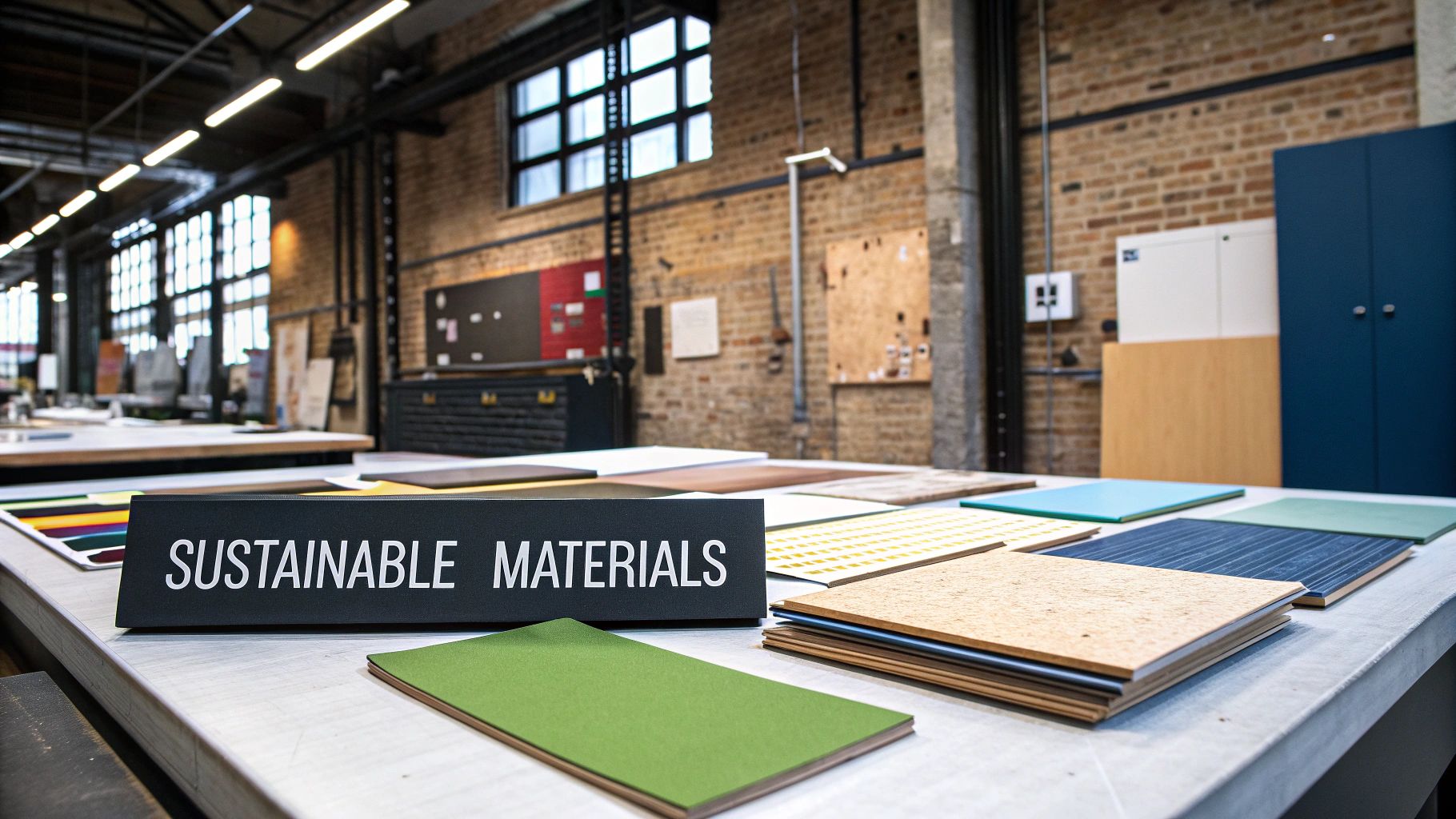
Imagine an office that doesn't feel like a sterile box, but more like a living, breathing ecosystem. That’s the entire idea behind biophilic design, a powerful trend that’s all about weaving natural elements right into the workplace. This is way more than just scattering a few sad-looking potted plants around—it’s a philosophy centered on creating a genuine connection between people and the natural world.
And this connection isn't just for looks. When you bring in elements like living walls, indoor gardens, natural light, and materials like wood and stone, the impact is profound. Study after study shows that these features can tangibly reduce employee stress, spark creativity, and even improve the air people breathe.
By 2025, biophilic design isn’t just a fad; it’s a cornerstone of commercial interiors. Research has proven that connecting with nature improves mood and well-being. That's why you see so many spaces now featuring living walls that double as natural air filters, vertical gardens that maximize greenery in tight spots, and plants used strategically to soften industrial edges.
Bringing The Outdoors In
The good news is you don’t need a massive architectural overhaul to get started. While soaring atriums and skylights are great, plenty of effective biophilic strategies can scale to fit any business.
The real goal is to create sensory links to nature. Think about how you can appeal to our built-in preference for natural environments.
- Direct Natural Elements: This is the most obvious route. It’s about bringing in living plants, water features, and flooding the space with natural light. Even a small herb garden in the breakroom can completely change the atmosphere.
- Indirect Natural Elements: This is where you use materials, colors, and patterns that mimic the outdoors. Think wood-grain desks, stone accent walls, or even carpeting with patterns that evoke flowing water. These subtle cues trigger the same positive feelings.
- Space and Place: This one is all about the feel of the space. It could mean creating open layouts with clear views to the outside or designing quiet nooks that feel like a secluded spot in a forest.
The core principle of biophilic design is that humans are hardwired to connect with nature. When we honor that connection in our workspaces, we create environments where people don't just work—they thrive.
Practical Applications For Any Office
You can start small and still see a big difference. Many of the same concepts that make a personal space feel great can be adapted for the office. For more inspiration, check out our guide to inspiring home office design ideas; you’d be surprised how well these tips translate to a larger commercial setting.
Here are a few practical ways to get this trend rolling:
- Maximize Natural Light: Arrange desks and common areas to take full advantage of any windows. Use lighter-colored paints and reflective surfaces to help bounce that sunlight deeper into the office.
- Introduce Diverse Greenery: Go beyond the single ficus in the corner. Mix it up with a variety of plants in different shapes and sizes. Hanging planters, shelf gardens, and small desk plants all add to the vibe.
- Use Natural Materials: When it’s time to pick out new furniture or finishes, lean toward wood, bamboo, stone, or textiles like wool and linen. They add a warmth and texture that synthetics just can't match.
Of course, once you’ve brought the green in, you have to keep it alive. For some straightforward advice on keeping your plants happy, this 7-Step Indoor Plant Care Guide for Thriving Plants is a fantastic resource. By making a few conscious choices, any business can create a healthier, more inspiring place for their team to be.
Building the Smart and Integrated Office
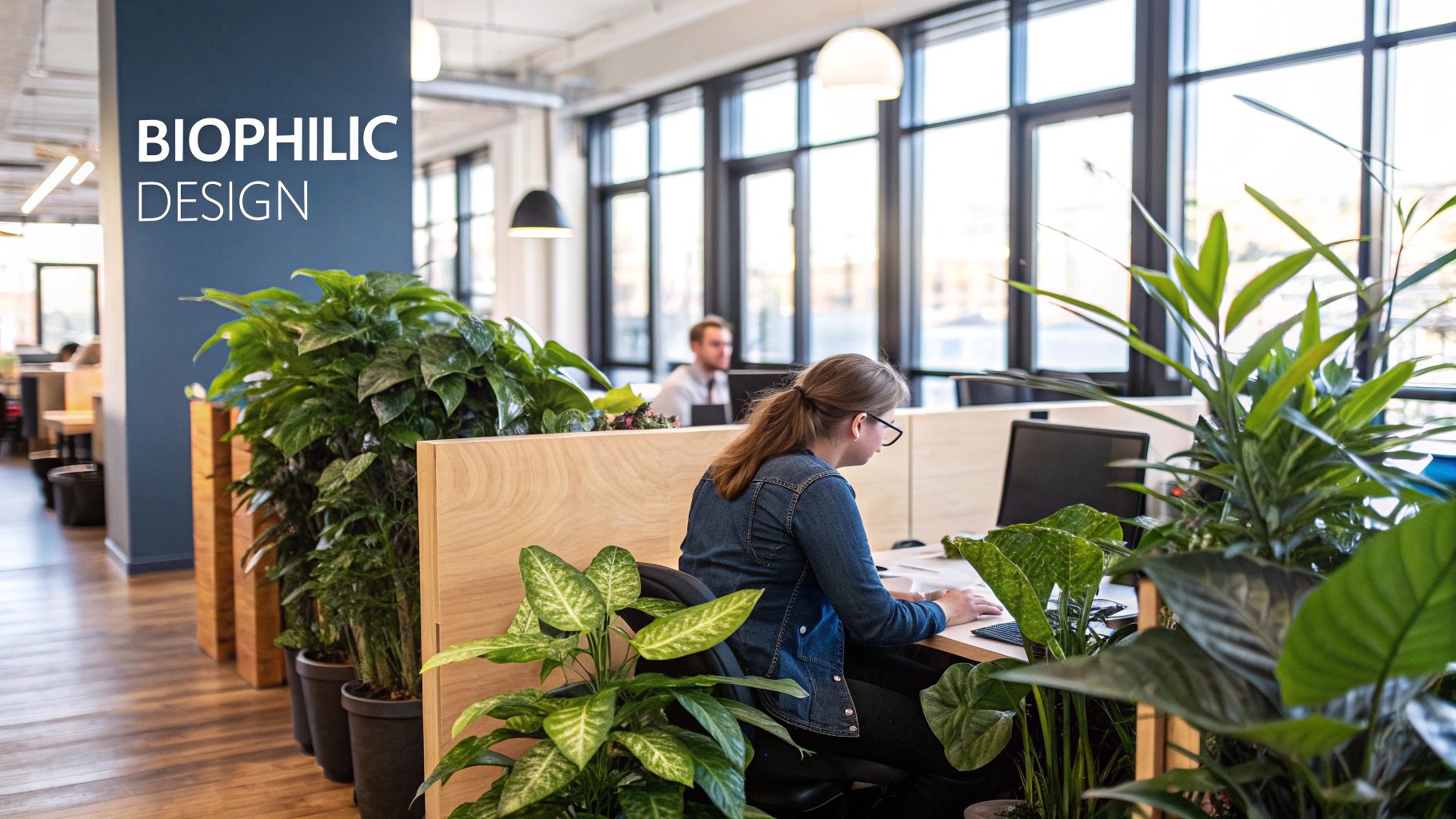
The best offices today feel less like static buildings and more like a central nervous system—intuitive, responsive, and incredibly efficient. This is one of the biggest commercial interior design trends right now: the fusion of technology and physical space. It’s all about creating an environment that works for its people, not the other way around.
We’ve moved way beyond just having fast Wi-Fi and a few outlets. A truly "smart" office is a fully integrated ecosystem where technology hums along seamlessly in the background. It’s a place where employees aren't fighting with cables or confusing room schedulers, which frees them up to focus on what really matters: collaboration and innovation.
Beyond Buzzwords: What a Smart Office Looks Like
So what does this intelligent integration actually look like on the ground? Imagine furniture with built-in Internet of Things (IoT) sensors that track how different spaces are being used. This gives facility managers real data on which areas are popular and which are sitting empty, allowing them to reconfigure layouts based on how people actually work.
Another great example is smart lighting that syncs with our natural circadian rhythms. These systems automatically adjust the light’s color and brightness all day long, helping to boost alertness in the morning and wind things down in the afternoon. It’s a subtle shift, but one that can make a huge difference in employee energy levels.
The goal of a smart office isn't to show off flashy tech. It's to make the technology disappear, creating an effortless experience where the environment itself supports productivity without any friction.
This idea is crucial for hybrid work. Seamless AV solutions aren't a luxury anymore; they're a must-have. Conference rooms need to be ready for instant connectivity, so remote and in-person team members feel like they're all in the same room.
The Rise of Science-Led Design
This blend of tech and design isn't just guesswork. It's driven by a data-first approach called "science-led design." Instead of relying on old assumptions, designers use analytics to inform every single decision. This could mean using desk booking systems to prevent wasted space or energy management platforms that shrink the building’s carbon footprint.
For companies looking to get the most out of every square foot, our article on 10 space-saving office ideas offers some practical tips that fit perfectly with this data-driven mindset. This approach effectively turns the office from a simple container for work into a high-performance tool.
Making Technology Invisible
The real sign of a successful smart office? When the tech is so well-integrated you barely notice it's there. That’s where thoughtful solutions for mounting and cable management come into play.
- Integrated Conference Rooms: A conference room with a sleek, wall-mounted display, speakers, and camera just looks clean and professional. Using smart AV mounts and hidden cable systems gets rid of the wire clutter, making the room feel organized and ready for business.
- Dynamic Presentation Spaces: Mobile TV carts can instantly turn any open area into a spot for a presentation or a quick huddle. This flexibility lets teams work wherever inspiration strikes, without being chained to a specific room.
- Personalized Workstations: Monitor arms are fantastic because they let employees adjust their screen height and angle, but they also clear a ton of valuable desk space. When you pair them with under-desk cable trays, you get a tidy, functional setup that boosts both focus and comfort.
By planning for these details, you create an environment where technology does its job without causing distractions or headaches. That’s how you get teams to connect and create effortlessly—and that's the true measure of a smart, integrated office.
Designing for Flexibility and Choice
Let's face it: the old-school office with its endless rows of assigned cubicles is officially a thing of the past. The smartest commercial interior design trends today are built around a simple, yet incredibly powerful idea: choice.
Instead of shoehorning everyone into a one-size-fits-all workspace, modern design gives people the power to pick the right spot for the task at hand. This concept, known as activity-based working (ABW), turns a static floor plan into a lively, dynamic ecosystem.
Think of it like this: your office becomes a bustling food hall instead of a single restaurant. Sometimes you need a quiet corner table for a focused conversation (a private pod), and other times you need a big communal table to hash things out with the team (a collaboration zone). This approach recognizes that our work needs are constantly in flux. One moment might call for deep, heads-down concentration, while the next requires a burst of creative brainstorming. A flexible office rolls with this natural rhythm instead of fighting against it.
The Blueprint for a Dynamic Office
Pulling off a great flexible workspace isn't about just randomly scattering cool-looking furniture around. It takes a deliberate strategy, carving out distinct zones designed for specific kinds of work. The ultimate goal is to create an environment that feels intuitive and empowering for everyone.
So, what does this "menu" of spaces look like? Here are the key zones that form the foundation of any truly flexible office:
- Focus Zones: These are the quiet sanctuaries for deep work. Think individual pods, small private rooms, or designated library-style areas where distractions are kept to an absolute minimum.
- Collaboration Zones: This is where the magic of teamwork happens. These are open areas with massive whiteboards, comfy lounge setups for casual chats, and large project tables where teams can spread out and get creative.
- Social Zones: A modern office is more than just a place to work; it's a community hub. Spaces like cafés, kitchens, and lounges are designed to spark those spontaneous conversations that build strong company culture.
- Learning Zones: These are adaptable areas built for training sessions, presentations, or all-hands meetings. Flexibility is key here, allowing the space to morph to fit different group sizes and presentation needs.
When you offer this kind of variety, you're giving your team the autonomy to manage their own productivity. This freedom doesn't just boost job satisfaction; it's been shown to spark innovation and improve overall output.
An office designed for flexibility is an office designed for people. It trusts employees to know what they need to do their best work and provides them with the tools and spaces to make it happen.
The Tools of Flexibility
To make this fluid environment actually work, you need the right gear. The trick is to choose furniture and technology that can adapt on the fly, allowing you to reconfigure spaces with almost no effort. This is what truly brings the concept of choice to life.
Here are a few essential ingredients:
- Modular Furniture: Sofas that can be rearranged into different shapes, desks that can be grouped for teamwork or separated for solo tasks, and seating that’s easy to move are non-negotiable.
- Mobile Partitions: Forget permanent construction. Lightweight, movable walls or screens let teams carve out private spaces whenever they need them.
- Adaptable Tech: Your technology has to be as mobile as your people. This is where solutions like mobile TV carts are a game-changer. You can roll one into a lounge area to instantly create a presentation space or bring it into a project zone for a quick video call with a remote colleague.
Ultimately, designing for flexibility means creating an environment that can evolve right alongside your business and your team. By breaking free from the rigid layouts of the past, you build a resilient, engaging, and highly effective workspace for whatever comes next.
Making Ergonomics the Foundation of Your Design
Not long ago, ergonomics was often the last thing on the checklist—an optional extra considered only after the floor plan was set and the paint was dry. That entire way of thinking is officially obsolete. Today's most effective commercial interior design trends put ergonomics right where it belongs: at the very foundation of the design process. It's the bedrock of any workspace that aims to be healthy, productive, and truly modern.
Think about it this way: you wouldn't build a gorgeous house on a crumbling foundation. In the same way, an office that looks fantastic but fails on ergonomics is destined to let its occupants down. It's a design that actively works against the physical well-being of the people it's supposed to serve, leading to nagging discomfort, constant distraction, and a real hit to performance. Great modern design integrates human wellness from the very first sketch.
This goes way beyond just picking a comfortable chair. It’s about building an entire ecosystem that moves and adapts with the human body. Foundational pieces like adjustable standing desks, truly supportive chairs, and articulating monitor arms aren't luxuries anymore. They are the non-negotiable building blocks of a high-functioning commercial interior.
The Real-World Impact of Ergonomic Design
Let’s walk through a common scene in a typical hot-desking setup. An employee grabs an open desk and immediately wastes the first 15 minutes of their day just trying to get comfortable. The monitor is too low, forcing their shoulders to slump. The desk is fixed at a height that’s all wrong for them, creating strain in their wrists and back. By lunchtime, they’re fighting off neck pain and a headache, and their focus is shot.
Now, let's replay that in an ergonomically designed space. The employee sits down, and with a single touch, raises the desk to their perfect standing height. They grab the monitor and effortlessly pull it to the ideal eye level using its articulating arm. What's the result? They dive right into their work feeling supported and energized, able to maintain that focus and comfort all day long. This is the direct line from ergonomics to efficiency.
Good ergonomics isn't about avoiding lawsuits; it's about unlocking human potential. When employees are physically comfortable and supported, their cognitive resources are freed up to focus on innovation, problem-solving, and collaboration.
Investing in ergonomics pays you back in tangible ways. Workspaces with solid ergonomic setups see a massive drop in musculoskeletal issues, which are a primary driver of absenteeism. Studies have shown that companies can cut down on lost workdays and see a real, measurable boost in productivity just by making physical well-being a design priority. For a deeper dive, check out the many benefits of using a standing desk in our detailed guide.
Ergonomics in a Flexible Workspace
The shift toward flexible, activity-based work makes a smart ergonomic strategy more critical than ever. When people are moving between focus pods, collaborative hubs, and quick touchdown spots, every single space has to be equipped to support them properly. This is where adaptable solutions really shine.
- Hot-Desking Stations: These shared spaces demand easy adjustability. A combination of height-adjustable desks and dual monitor arms with full movement ensures anyone, regardless of their height or preference, can create a personalized setup in seconds.
- Collaborative Zones: Ergonomics here is a group effort. Mobile TV carts let teams position a large screen at a comfortable viewing height for everyone in the room, getting rid of the neck-craning that happens during presentations or video calls.
- Focus Pods: Even in tiny, quiet nooks, ergonomics is key. Wall-mounted workstations can create compact but comfortable spaces for individual work, saving precious floor space without sacrificing proper posture.
The table below breaks down how to match the right ergonomic gear to different work zones in a modern office.
Ergonomic Solutions For Modern Work Zones
Every area in a flexible office serves a different purpose, and the furniture should reflect that. Here’s a quick guide to pairing the right ergonomic and AV solutions with common workspace zones to maximize both comfort and function.
| Workspace Zone | Primary Activity | Recommended Ergonomic Solution | Recommended AV Mount |
|---|---|---|---|
| Focus Workstation | Individual, concentrated tasks | Height-Adjustable Standing Desk & Ergonomic Chair | Articulating Dual Monitor Arm |
| Hot Desk / Touchdown | Short-term, varied user tasks | Electric Sit-Stand Desk with Memory Presets | Single Monitor Desk Mount |
| Huddle Room | Small group collaboration, brainstorming | Mobile Whiteboard, comfortable seating | Mobile TV Cart / Stand |
| Conference Room | Formal meetings, presentations | Ergonomic conference chairs | Large Format TV Wall Mount |
| Quiet Pod / Nook | Private calls, deep focus work | Wall-Mounted Sit-Stand Workstation | Integrated Monitor VESA Mount |
By tailoring the equipment to the activity, you create a more intuitive and supportive environment where people can seamlessly transition between tasks without fighting their furniture.
This infographic powerfully illustrates the business case for ditching rigid, one-size-fits-all stations in favor of these more adaptable, ergonomic solutions.
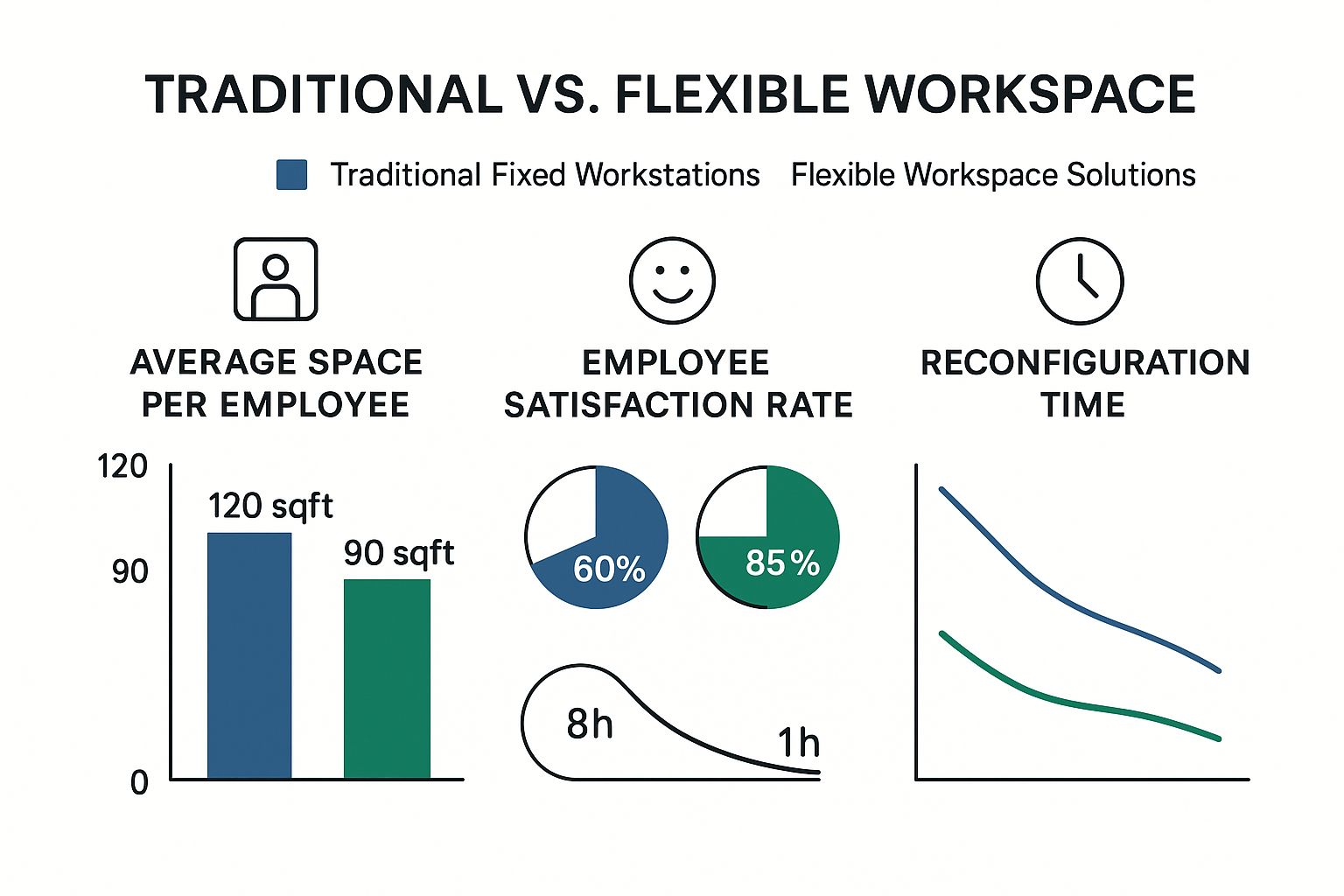
The data is clear: flexible designs don't just use space more efficiently. They also send employee satisfaction soaring and make the entire office more agile and ready for whatever comes next.
When it comes down to it, making ergonomics the foundation of your design is a strategic move that pays dividends in employee health, happiness, and your company's bottom line. It’s the invisible framework that holds up every other trend, ensuring that your beautiful, modern office is also a place where your team can do their best work.
Answering Your Commercial Design Questions
Stepping into the world of commercial interior design can feel overwhelming. You're trying to balance the latest trends with the hard realities of your business needs, and that's bound to bring up some questions. This FAQ is designed to give you clear, straightforward answers to the most common queries we hear. Think of it as your quick guide to making smart, confident decisions for your own workspace.
How Can I Implement These Trends on a Limited Budget?
A tight budget doesn't mean you have to sit on the sidelines. The secret is to aim for high-impact changes that don't break the bank. Instead of thinking about a massive, all-at-once renovation, focus on strategic upgrades that make the biggest difference in your team's day-to-day life.
You could start with the fundamentals of ergonomics. Investing in good monitor arms or supportive ergonomic chair cushions for your current setup delivers an immediate wellness win. Another easy move is bringing in biophilic elements—even a few affordable potted plants can liven up a space. And don't forget the free stuff: simply rearranging desks to maximize the natural light you already have costs nothing but can dramatically improve the office vibe.
Which Trends Offer the Best Long-Term Return on Investment?
If you're looking for the best bang for your buck over the long haul, put your money on trends that directly boost employee productivity, well-being, and retention. These aren't just cosmetic upgrades; they're smart investments in your most valuable asset—your people.
- Ergonomics: This is a big one, maybe the most important. A proper ergonomic setup doesn't just make people more comfortable; it reduces absenteeism and helps them focus. It pays for itself through higher output and fewer health-related complaints.
- Flexibility: An agile workspace with different zones for different tasks is a gift that keeps on giving. It ensures your office can evolve as your company grows or work styles shift, saving you from expensive reconfigurations down the road.
- Biophilic Design: The science is clear: bringing elements of nature indoors reduces stress and sparks creativity. This trend is a long-term play for employee satisfaction and mental health, both of which are key to keeping your best people around.
Your best investment will always be in your team. Any design choice that makes them healthier, happier, and more effective is going to yield the highest returns. When you create a physical environment that supports them, you're building a stronger, more resilient organization.
How Do I Future-Proof My Office Design?
Future-proofing isn't about gazing into a crystal ball to predict the next big thing. It's about building an environment that can adapt. The key principles are adaptability and modularity. Steer clear of anything too permanent or single-purpose that will be a headache to change later.
Opt for modular furniture that you can easily move and reconfigure. You should also build out a solid tech infrastructure that can handle what you need now and what you might need later—think plenty of power outlets and data access points throughout the space. Lastly, keeping your design looking and feeling fresh requires regular care. Following a comprehensive commercial building maintenance checklist is a simple way to stay on top of upkeep.
Is an Open-Plan Office Still a Good Idea?
The classic, wall-to-wall open-plan office has gotten a lot of flak, and for good reason—it can be noisy and incredibly distracting. The modern take isn't to ditch the concept entirely but to strike a better balance. The most successful commercial interior design trends right now are all about the hybrid model.
This means you keep your open, collaborative areas but you also provide plenty of alternatives. Think easily accessible quiet zones, private pods for phone calls, and small, enclosed rooms for deep-focus work. The idea is to offer a whole spectrum of environments so employees can pick the one that fits the task at hand. It truly is the best of both worlds.
Where Should I Start My Office Redesign Process?
The absolute best place to begin is with your team. Before you even think about buying a new chair or picking out paint colors, talk to the people who use the space every day. Find out what's working for them and, more importantly, what isn't. You can send out simple surveys or just hold a few informal group chats to uncover their biggest pain points.
Once you have that feedback, you can start mapping things out. Based on what your team told you, identify the key zones you'll need: areas for collaboration, for focus, for socializing, and for learning. When you start with your people, you guarantee your redesign will solve real problems and result in a workspace your team will actually love to use.
Ready to build a workspace that’s as dynamic and forward-thinking as your team? At Mount-It!, we provide the ergonomic furniture and smart AV mounting solutions that bring modern commercial interior design trends to life. From height-adjustable desks to mobile TV carts, we have the tools you need to create a healthier, more productive, and flexible environment.
Explore our full collection of commercial solutions and start building the future of your workspace today at https://www.mount-it.com.
